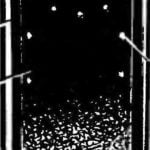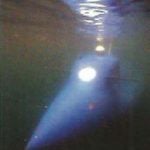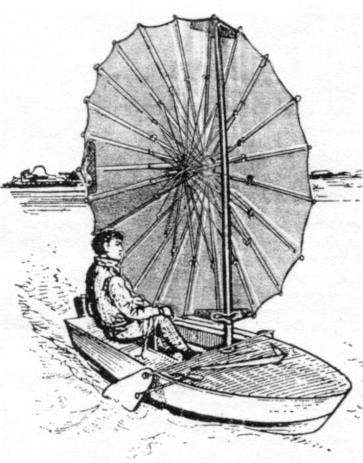After the completion of the housing Assembly, the joints between the panels are filled with epoxy filler, then after curing, vyshkurivaetsya the entire outer surface. Inside the joints of the sheathing with the framing members are filled with epoxy filler, after which the body is covered with two or three coats of varnish parquet and painted with enamel.
In the transom Board at the level of the bottom glue two bottle from plastic bottles – using them will merge within the body water. The lower part of the cockpit was covered two floorboards (duckboards) grid of wooden laths with cross-section 20×80 mm, covered with two layers of varnish parquet.
Additional parts and steering feather is cut from plywood 12 mm thick. the Profile of all of them symmetrical – rounded in front and pointed behind. After processing and finishing viskazivaniya plywood parts are covered with several layers of varnish parquet, and then, after polishing, bright enamel.
The axis of rotation svarca is a steel stud with thread M14 on one of its ends; additional parts fixed on it between the two nuts and two washers. Fixing sverzov on the yacht is made by rubber cord shock absorber with a pair of hooks at its ends. To move additional parts does not pop up, they are attracted by a pair of Vertov installed on the deck ducks.
The frame of the umbrella-bot
Steering pen is mounted on the transom of the Dinghy using the simplest of loops, each of them consists of a bracket, bent from 6 mm steel rod in the form of the letter “G,” and the mate of the same rod, resembling a ballpoint pin with a ring. Hinges are fixed with epoxy glue in the holes in the transom and in the front part of the pen. Rumple, of oak or beech slats, with the tail feather it is connected with a hinge.
Mast umbrella-bot – swivel, pine, its length is 2600 mm, the diameter at the top is 30 mm – 50 mm. If the strength of the mast is insufficient, it makes sense to paste over it with two layers of fiberglass using epoxy resin. The supports of the mast on the umbrella-bot are the steps (stainless steel beaker with an internal diameter of 50 mm), mounted on the tail housing and yoke from a steel strip, fixed to the frame 1. Accordingly, in the lower part of the mast mounted spurs – a metal or plastic cap with an outside diameter of 48 mm, and in the area of the upper support clamp mast – steel belt with a width of about 50 mm.
Steering gear:
1 – rumple (beech or oak, block 30×30);
2 – joint tiller (bolt with nut); 3 – cheek (duralumin, s2,5); 4 – steering pen (12 plywood s); 5 – loop hinges (steel, rod d6)
Side swiercz Assembly:
1 – swiercz (plywood s 12); 2 – nut M14; 3-svarca (aluminum, pipe 18×2)
As mentioned above, as the sails on the boat used a beach umbrella with a diameter of 2 m, which can be purchased at a sports store where camping equipment is sold, or ordered through the Internet.
Long leg-stand, the much needed beach umbrella, a sail is not required – it should be cut flush with the end moving the rack sleeve at the maximum opening of the umbrella.
The umbrella-sail has three knots attaching it to the mast. The top (hinge) of the host on which it is suspended to the mast, allows you to change the position of the umbrella-sail relative to the mast when changing tack. It consists of a pair of dural plates, mounted on two (or three) spokes of the umbrella with a few M5 screws with nuts, and U-shaped loop of steel rod of 6 mm in diameter, whose ends are pre-cut M6 thread. On the mast well secured counterpart of the node – hook is bent in the form of the letter G, on the “leg” of which is threaded M6. Each of the bottom nodes also consists of a pair of dural plates and clamps that hold the sunshade on the mast when changing tack. It should be noted that the lower nodes are used for the attachment thereto of the sheet – linen or synthetic rope with a diameter of about 12 mm.
When setting up the umbrella-bot the main thing-to combine the center of the sail (CPU) with the center of lateral resistance (MKS) unit. Note that the CPU of the dome of the umbrella is located at a distance of about 0.5 m from the leading edge. Well, CBS housing will need to be determined experimentally. This sailboat is arming surcame and tail feather and down to the water; around svarca to the side of the hull snapped Lin. When pulling the Lin perpendicular to the median plane of the boat, and it will move parallel to the longitudinal axis, the location of the binding line and is the center of lateral resistance. However, most likely, in tension Lin the housing starts to turn, and in this case, the binding line will have to shift and repeat the experiment as long as the body will not begin to move parallel to the longitudinal axis.
If it turns out that the CPU and the CBS of the case do not match, readjust the position of CBS can reject sverzov forward or backward. To change the position of the CPU deflection of the mast.
A well-tuned sailing ship must have a small tendency to operate (go luff) that helps with a sharp wind to transfer the boat to head to wind position – nose to the wind.
I. MNEVNIKI
Recommend to read
 “COAT” FOR DOOR
“COAT” FOR DOOR
I want to offer the readers I used in the method of the door trim: it is simple, inexpensive, convenient and allows you to achieve a good zvono and heat insulation front door. And... DOUBLE KIT
DOUBLE KIT
Submarine kit built by St. Petersburg-Mikhail Puchkov. The double submarine (captain and passenger). Length - 5400 mm, width 1150 mm, height - 1300 mm, sediment - 660 mm, weight - 3 tons...


